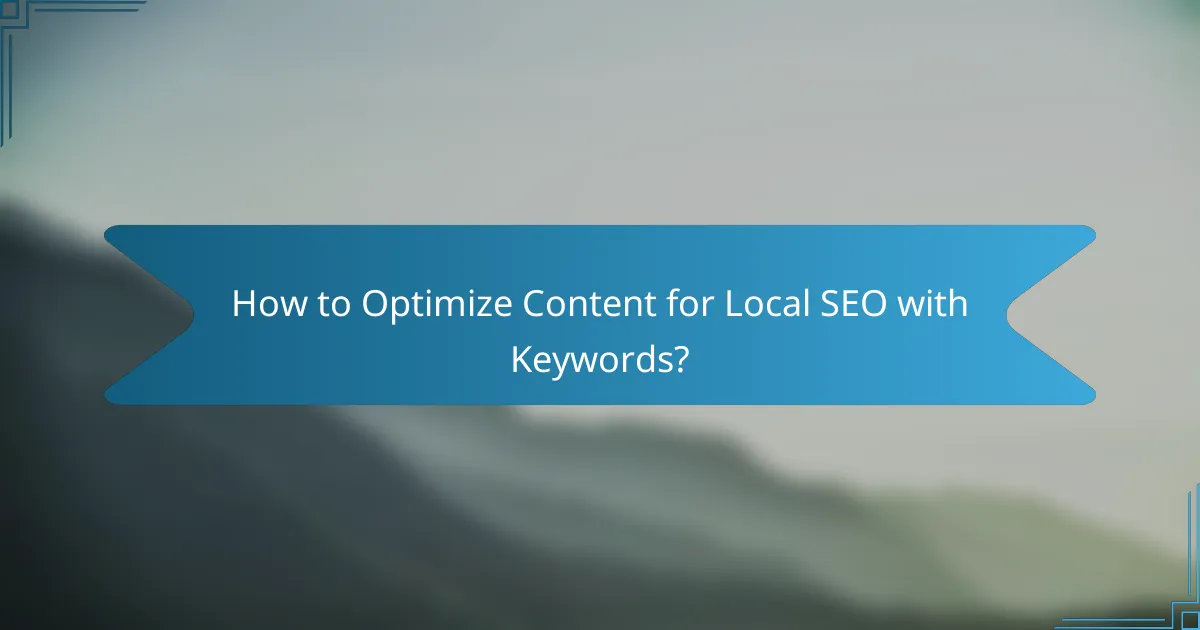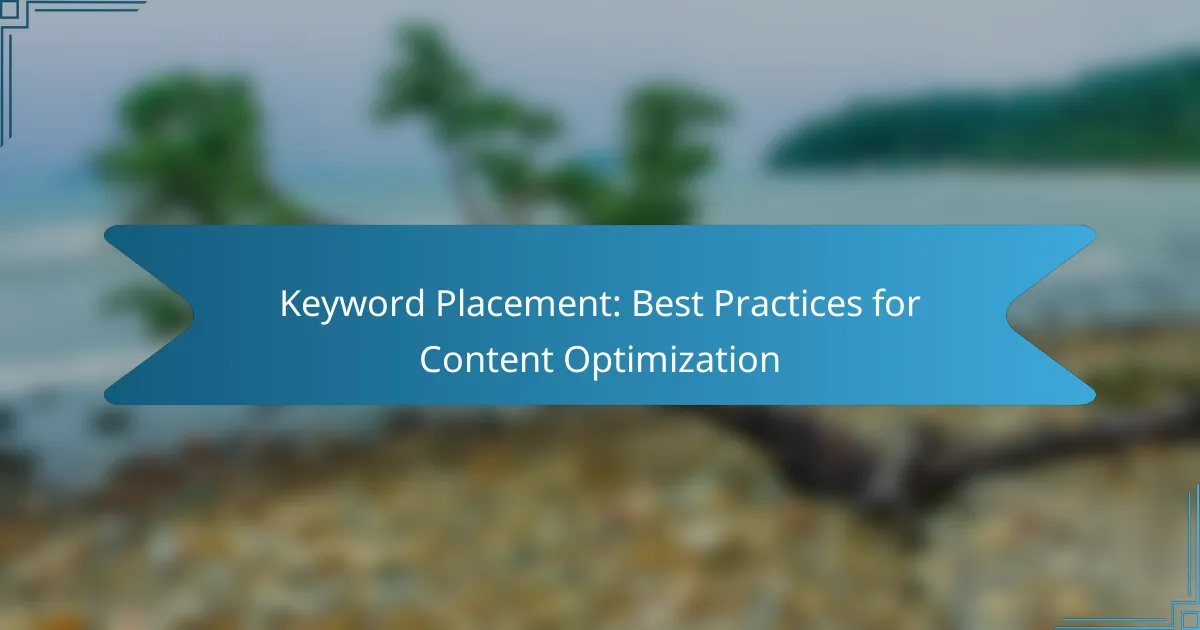Effective keyword placement is essential for optimizing content and enhancing its visibility in search engine results. By strategically incorporating keywords in titles, headings, and throughout the body of the text, you can improve your content’s relevance while ensuring a natural flow. Utilizing various tools can further assist in identifying optimal keyword strategies, allowing for informed decisions that boost SEO performance.

What Are the Best Practices for Keyword Placement in Content?
Effective keyword placement is crucial for optimizing content for search engines and improving visibility. Best practices include strategically using keywords in titles, headings, and throughout the body while ensuring they fit naturally within the text.
Use keywords in titles and headings
Incorporating keywords in titles and headings is essential for signaling the main topic of your content to both readers and search engines. Aim to place your primary keyword at the beginning of the title and in at least one subheading to enhance relevance.
For example, if your article is about “Healthy Eating Tips,” a title like “Healthy Eating Tips for a Balanced Diet” clearly communicates the focus. This not only aids in SEO but also attracts users searching for that specific information.
Incorporate keywords naturally in the body
Integrating keywords naturally throughout the body of your content helps maintain readability while optimizing for search engines. Aim for a keyword density of around 1-2%, which means using your primary keyword once or twice for every 100 words.
For instance, if your keyword is “digital marketing,” mention it in the introduction, a few times in the main content, and in the conclusion. Avoid keyword stuffing, as this can lead to penalties from search engines.
Optimize meta descriptions with keywords
Meta descriptions should include relevant keywords to improve click-through rates from search engine results. A well-crafted meta description provides a concise summary of the content while enticing users to click through.
Keep meta descriptions between 150-160 characters and include your primary keyword. For example, “Discover effective digital marketing strategies to boost your online presence” effectively uses the keyword while remaining engaging.
Utilize keywords in image alt text
Using keywords in image alt text enhances accessibility and provides additional context to search engines about the content. Alt text should describe the image while incorporating relevant keywords where appropriate.
For example, if you have an image related to “social media marketing,” the alt text could read “Infographic on social media marketing strategies.” This practice not only aids SEO but also improves the user experience for those using screen readers.
Maintain keyword density
Maintaining an appropriate keyword density is vital for optimizing content without compromising quality. A density of 1-2% is generally recommended, ensuring that keywords are present but not overwhelming.
Regularly review your content to ensure that keywords are distributed evenly and contextually relevant. Tools like SEO analyzers can help monitor keyword density and suggest adjustments to enhance optimization.

How Does Keyword Placement Affect SEO Performance?
Keyword placement is crucial for SEO performance as it directly influences how search engines rank content. Properly positioned keywords help search engines understand the topic of your content, improving visibility and relevance in search results.
Improves search engine rankings
Strategic keyword placement can significantly enhance your search engine rankings. Placing keywords in key areas such as the title, headings, and the first 100 words of your content signals to search engines what your page is about. Aim for a natural integration of keywords to avoid penalties for keyword stuffing.
For instance, if you are targeting “best coffee shops in London,” include this phrase in your title and subheadings. This approach helps search engines categorize your content effectively, increasing the likelihood of higher rankings.
Enhances user engagement
Effective keyword placement not only aids search engines but also enhances user engagement. When users find relevant keywords in headings and throughout the text, they are more likely to stay on the page and explore further. This engagement can lead to lower bounce rates and higher time-on-page metrics.
Consider using related keywords and synonyms to enrich your content. For example, instead of repeating “coffee shops,” you might use “cafés” or “breweries,” which keeps the content engaging while still targeting the main topic.
Increases click-through rates
Well-placed keywords can lead to higher click-through rates (CTR) from search engine results pages. When users see keywords that match their search queries in your meta titles and descriptions, they are more inclined to click on your link. This is particularly important for competitive keywords.
To optimize for CTR, ensure your title tags and meta descriptions are compelling and include your primary keywords. For example, a title like “Top 10 Coffee Shops in London You Must Visit” is likely to attract more clicks than a generic title.

What Tools Can Help with Keyword Placement?
Several tools can assist with effective keyword placement, helping to optimize content for search engines. These tools provide insights into keyword performance, competition, and search volume, enabling better strategic decisions.
Google Keyword Planner
Google Keyword Planner is a free tool that helps users discover keywords related to their business and see how a list of keywords might perform. It provides data on search volume, competition level, and suggested bid prices for paid campaigns.
To use Google Keyword Planner effectively, start by entering a few seed keywords relevant to your content. The tool will generate a list of related keywords along with metrics that can guide your placement strategy. Focus on keywords with high search volume and manageable competition for optimal results.
SEMrush
SEMrush is a comprehensive SEO tool that offers keyword research, site audit, and competitive analysis features. It allows users to analyze keyword difficulty, search volume, and trends over time, which is crucial for strategic keyword placement.
When using SEMrush, take advantage of its keyword magic tool to explore long-tail keywords that may have lower competition. This can help you identify niche opportunities that can enhance your content’s visibility. Regularly monitor your keyword rankings to adjust your strategy as needed.
Ahrefs
Ahrefs is another powerful SEO tool that excels in keyword research and backlink analysis. It provides detailed insights into keyword difficulty, search volume, and click-through rates, which can inform your content optimization efforts.
To maximize the benefits of Ahrefs, utilize its keyword explorer feature to find relevant keywords and analyze their potential traffic. Pay attention to the “parent topic” suggestions to ensure your content aligns with broader themes that attract more visitors. Regularly update your keyword strategy based on performance data to stay competitive.

What Are Common Mistakes in Keyword Placement?
Common mistakes in keyword placement can significantly hinder content optimization. These errors often include overstuffing keywords, ignoring user intent, and neglecting long-tail keywords, all of which can negatively impact search engine rankings and user experience.
Overstuffing keywords
Overstuffing keywords refers to the practice of excessively using keywords in content, which can lead to a poor reading experience and penalties from search engines. Instead of enhancing visibility, this tactic often results in lower rankings as search algorithms prioritize quality over quantity.
A good rule of thumb is to maintain a keyword density of around 1-2%, ensuring that keywords fit naturally within the text. Focus on creating valuable content that addresses user needs rather than forcing keywords into every sentence.
Ignoring user intent
Ignoring user intent means failing to consider what the audience is actually searching for when they use specific keywords. This oversight can lead to content that does not resonate with users, resulting in higher bounce rates and lower engagement.
To align with user intent, conduct keyword research to understand the context behind searches. Use tools like Google Trends or Answer the Public to identify common questions and topics related to your keywords, ensuring your content meets user expectations.
Neglecting long-tail keywords
Neglecting long-tail keywords involves overlooking more specific phrases that target niche audiences. These keywords typically have lower search volume but higher conversion rates, as they cater to users with particular needs or questions.
Incorporate long-tail keywords naturally into your content to capture targeted traffic. For example, instead of just using “shoes,” consider phrases like “best running shoes for flat feet.” This approach can improve visibility in search results and attract more qualified leads.

What Are the Criteria for Effective Keyword Research?
Effective keyword research focuses on identifying terms that resonate with your target audience while balancing search volume and competition. This process involves analyzing trends and understanding the context in which keywords are used to optimize content effectively.
Relevance to target audience
Relevance is crucial in keyword research, as it ensures that the selected keywords align with the interests and needs of your target audience. Start by creating buyer personas to understand their preferences and pain points, which will guide your keyword selection.
Utilize tools like Google Trends or social media insights to discover what topics are currently engaging your audience. This approach helps in selecting keywords that not only attract traffic but also convert visitors into customers.
Search volume and competition
Search volume indicates how many users are searching for a particular keyword, while competition reflects how many other sites are targeting the same terms. Aim for keywords with a balance of decent search volume and manageable competition to maximize visibility.
Tools such as SEMrush or Ahrefs can provide insights into these metrics. Generally, targeting keywords with moderate search volume and lower competition can yield better results than high-volume, highly competitive terms.
Trends in keyword usage
Monitoring trends in keyword usage helps you stay ahead of shifts in consumer behavior and search patterns. Regularly review your keyword performance and adapt your strategy based on emerging trends to maintain relevance.
Consider seasonal variations or industry-specific events that may influence keyword popularity. For example, keywords related to holiday shopping typically see spikes in search volume during specific months, making timely adjustments essential for optimization.

How to Optimize Content for Local SEO with Keywords?
To optimize content for local SEO with keywords, focus on incorporating location-specific terms and phrases that your target audience is likely to search for. This approach enhances visibility in local search results, helping businesses attract nearby customers.
Research Local Keywords
Start by identifying keywords that are relevant to your business and location. Use tools like Google Keyword Planner or local search trends to find terms that potential customers are using. Aim for a mix of broad and long-tail keywords that include your city or region.
Consider the intent behind the keywords. For example, someone searching for “best coffee shop in Boston” is likely looking for immediate options, while “coffee shop reviews Boston” may indicate a longer decision-making process. Tailor your content to match these intents.
Incorporate Keywords Naturally
Once you have your keywords, integrate them naturally into your content. Place primary keywords in key areas such as the title, headings, and first 100 words. However, avoid keyword stuffing, as this can harm readability and SEO performance.
Use synonyms and related phrases throughout your content to enhance keyword relevance without compromising flow. For example, if your primary keyword is “plumber in Miami,” you might also use “Miami plumbing services” or “emergency plumber Miami” in your text.
Optimize Meta Tags and Descriptions
Meta tags and descriptions are crucial for local SEO. Include your primary keywords in the title tag and meta description to improve click-through rates. Ensure these elements are concise, compelling, and accurately reflect the content of the page.
For local businesses, adding location details in meta descriptions can attract more local traffic. For instance, a title like “Affordable Plumber in Miami – 24/7 Service” clearly communicates both the service and location.
Utilize Local Listings and Citations
Claim and optimize your business listings on platforms like Google My Business, Yelp, and local directories. Ensure that your business name, address, and phone number (NAP) are consistent across all listings, as this consistency boosts local SEO credibility.
Incorporate relevant keywords in your business descriptions on these platforms. For example, if you run a bakery in San Francisco, mention “freshly baked goods in San Francisco” to enhance local search visibility.
